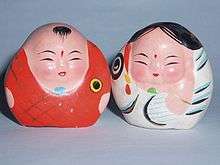Huishan clay figurine
Huishan clay figurines are a folk craft of Wuxi, Jiangsu Province, China, originating in the Ming Dynasty roughly 400 years ago.[1]
They are generally divided into two categories:[2]
- Mold-made "simple" or "coarse" figurines, which are highly stylised, with bright colours, usually drawing inspiration from folk traditions and decorated with symbols of good luck, prosperity, and happiness.
- Purely hand-crafted "fine" figurines, with characters more often drawn from Chinese myths and legends and characters in classical opera.
The most iconic kind of Huishan clay figurines are chubby babies with outsized heads and wide smiles which hold plants, animals or household objects representing heath, wealth, or happiness, often through puns.
They are made from soil dug from a meter below ground in the Huishan region, which provides excellent plasticity.[3]
Gallery
 Fu, Xi figurines
Fu, Xi figurines Qing Style
Qing Style
gollark: 1TB of *flash* storage for $30? Sounds very fishy.
gollark: Why would you buy 1 TB flash drive if you can only use it at glacially slow USB 2 speeds?
gollark: They lose data if stored without power for a while, apparently.
gollark: Probably. I don't know if this is actually going to be any use, though.
gollark: I mean... arguably? Ish?
See also
References
- "Huishan Clay Figurines - Google Arts & Culture". Google Cultural Institute. Retrieved 10 September 2018.
- "Wuxi Clay figurines (无锡泥人)". cn.hujiang.com. Retrieved 10 September 2018.
- 1959年6月,郭沫若参观无锡惠山泥人厂时即兴作诗:人物无古今,须臾出手中;衣冠千代异,肝胆一般同;造化眼前妙,流传域外雄;集中人八百,童叟献神功。
External links
This article is issued from Wikipedia. The text is licensed under Creative Commons - Attribution - Sharealike. Additional terms may apply for the media files.
